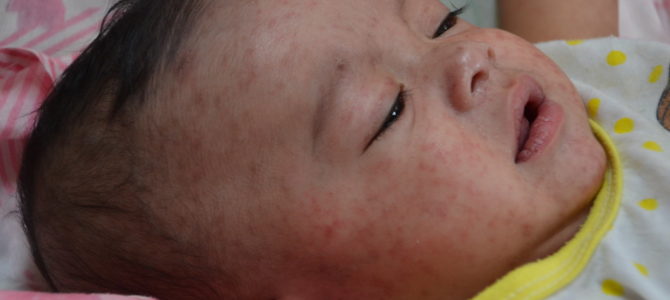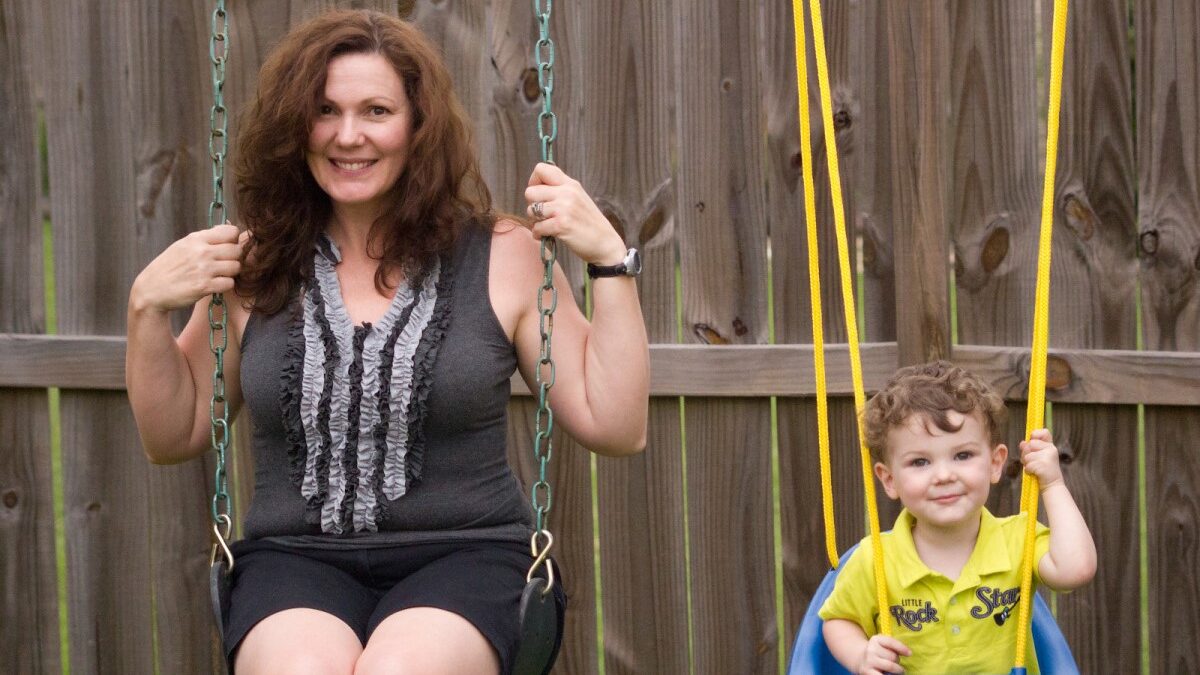
Jilly Moss is the mother of a young baby in London. On April 14, she shared a series of pictures of her daughter, Alba, who caught measles and was admitted to the hospital. The pictures document how sick her tiny daughter still was after eight days of being treated by doctors and nurses for the virus, and demonstrate that this disease is an incredibly serious and dangerous one for babies, small children, and the immune-compromised.
Measles was, until recently, eradicated in most of the developed world, so Moss is trying to spread awareness of its seriousness. Too many parents believe that measles is mostly a rash, akin to the chickenpox, something kids can quickly bounce back from then have lifelong immunity. The reality isn’t so. It’s important that everyone possible get vaccinated to protect those, like Alba, who are too young or otherwise unable to be vaccinated.
Moss opens her viral post noting that: “Doctors and Nurses at Chelsea West hospital have asked if we will share photos of Alba to educate about vaccinations … She was too young for her [measles, mumps, and rubella] MMR vaccination when she got sick which meant she has had to fight this killer virus with no immunity. Measles is not ‘just a rash’ it can cause blindness, encephalitis, and pneumonia.”
The MMR vaccine has had a lot of bad press, starting with the famously debunked work of Andrew Wakefield, who lost his medical license due to scientific fraud. Wakefield tied autism and vaccines together, igniting the fears of a generation of parents that vaccinating their babies would cause developmental regression and catastrophic neurological issues. No scientific consensus ties thimerosal, a vaccine preservative, to autism. Despite more than a decade of careful rebuttals by the medical community and the removal of thimerosal from the vaccine, parental fears about vaccines have only grown.
Growing Number of Vaccine Exemptions
In the shadow of these fears, vaccination exemptions have grown, leading to pockets of people who are not protected by either the vaccines themselves or herd immunity. And it’s in these places that outbreaks of diseases, declared eliminated in places like North America, have begun to occur more and more often.
The MMR vaccine is safe, and certainly much safer than measles itself. Moss, above pictures of her sweet baby with a stuffed rabbit in a hospital bed, wrote:
It has been absolutely horrific watching our daughter fight this with her eyes swollen shut for 4 days. She has been in the dark, scared with a high fever that lasted for over two weeks. In hospital she has been scanned, X-rayed poked prodded bloods taken, lumbar punctures done, canulars fitted, swabs taken, ECG Eccos, obs done every 20 mins, tube fed, on a drip, oxygen, pumped full of drugs, anti-inflammatory pain relief antibiotics you name it she’s had it. The truth is this all could have been prevented if the protection layer of older kids above Alba had been vaccinated.
Major side effects from the vaccine are extremely rare. The most common are sore arms, a fever, a mild rash, and joint pain. Compared to actually getting measles, or negligently causing another person to get infected due to not vaccinating, these side-effects are far less painful and long-lasting. Another common myth about the vaccine is that it can cause “viral shedding” (or infect other people) and that the recently vaccinated need to actually quarantine themselves. This is untrue.
While the measles vaccine is a “live” vaccine, it is an attenuated one, meaning that “it contains a live measles virus that has been treated to be weakened so that it is not capable of causing an infection, but will still reproduce enough to cause an immune reaction, and therefore build up immunity to measles.”
The idea of exposing your child to something that could potentially harm her, and in a catastrophic way, is terrifying. The fears of parents who are vaccine hesitant are real and need to be dealt with rationally and compassionately, instead of with mocking or derision.
Indeed, as this insightful Vox article from someone who married an anti-vaccine person notes, “This is the beating heart of any real discussion about anti-vaxxers. It’s impossible to understand their position without considering the amount of fear that goes into the anti-vaccine narrative, and considering how people construct and deal with fear.”
This fear might drive many people who are worried about vaccines, and learning how to address the fear and move past it could be the key to making sure more children and adults are fully vaccinated. Adam Mongrain, the author of the Vox article, continues:
When easing somebody’s fears, love is rarely enough—empathy is needed, especially when you want to persuade. Refusing to engage in any open-minded discussion, to concede that things can go wrong, to admit that it’s possible we don’t know everything: That kind of condescension had gotten me nowhere with my wife and her daughter no closer to vaccinations. It hasn’t gotten the broader fight against anti-vaxxers very far either.
Exposing Other People’s Babies to Danger Is Cruel
We have, in many ways, almost fallen victim to our own successes in health care. Vaccines work, and work so well, that the diseases they’re meant to prevent have faded from our collective memories. Instead of knowing children in our classes forever changed by polio, as parents, we fear side effects from the very treatments meant to spare our children from harm and danger. This false equivalency is ultimately leaving more babies and vulnerable people exposed and at risk, without protection from a vaccinated population around them.
It’s important to look at images like those shared by Moss of her daughter, to read her experiences from the hospital of the fear and pain they faced, so we can remember what these illnesses are truly like, and help educate people on how safe shots really are and how rare side effects are, especially when compared against the diseases themselves.









